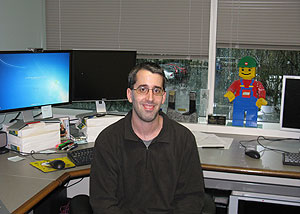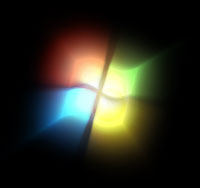Editor’s note:
This is the fifth story in “
Seven Behind Windows 7
,” a series featuring employees who helped build the new operating system.
REDMOND, Wash. – Jan. 25, 2010 – Months before Windows 7 launched, Aaron Dietrich’s boss forwarded him an early product review from CNET, an online technology news site. Until then, Dietrich hadn’t heard an outsider’s take on the new operating system. When he read the article, he found a prominent—and glowing—mention of lightning-fast start-up times.

“I always viewed myself as just one piece of the whole Windows puzzle,” Dietrich says. “It’s really when we brought it all together that we got such a great product.”
“It gave me a really good feeling,” Dietrich says. “I thought, ‘Wow, it’s not just that we’re on the right path, but we’re really making a change in perception for reviewers and the general public here.'”
As senior development lead on the Windows Client Performance team, Dietrich had toiled to make sure Windows 7-based PCs would fire up like rockets. But he was surprised again and again when praise for the faster start-up performance popped up repeatedly in the press and in the blogosphere.
“It’s not a fancy new UI feature,” he said. “It’s not that thing in your face all the time like a desktop feature or window switcher or something like that.” Still, he took pride in the kudos that Windows 7 was receiving.
Dietrich, who came to Microsoft nine years ago after completing graduate studies at Rochester Institute of Technology, worked with Windows 7 features teams to keep the operating system lean enough to clock significantly faster start-up times. He said it really did take a village to build Windows 7.
“I always viewed myself as just one piece of the whole Windows puzzle,” he said. “It’s really when we brought it all together that we got such a great product.”
The Microsoft News Center talked recently with Dietrich about his work on Windows 7.
The News Center: What was your role working on Windows 7?
Dietrich: For Windows 7, I was on the Windows Client Performance team. Rather than owning a specific feature, we kind of work as a liaison with many different teams within Windows to help them analyze and resolve performance issues with the operating system.

Dietrich was pleasantly surprised when he read an early review of Windows 7 that praised startup performance. “I thought, ‘Wow, it’s not just that we’re on the right path, but we’re really making a change in perception for reviewers and the general public here,’” he says.
The News Center: How did you increase start-up performance in Windows 7?
Dietrich: There were a couple of key features that allowed us to get better boot times. The first was we introduced what we call the fast boot feature, which allows some parts of boot to happen in the background while Windows is discovering and initializing devices. That helped us gain up to 25 percent of our boot time over Windows Vista, depending on the hardware.
The other big one was that we significantly reduced the size of the operating system required to be read from disk in order to boot. Whereas Windows Vista required somewhere on the order of 220 to 240 megabytes of operating system code to boot, Windows 7 requires anywhere from 140 to 180 megabytes, depending on the configuration of the system.
The News Center: What was a typical day like working on Windows 7?
Dietrich: As I said, we worked with other teams to try and help them design the right features and do analysis to make sure they were performing the way they expected them to. As the teams built their features, occasionally regressions in performance would come in. Bugs do happen. We have a lot of checks in place called “perf gates” that run on every build produced daily in Windows. That monitors everything from boot times to shutdown time and a bunch of other metrics. If any of them ever regressed, we jumped on that, did some analysis, and tried to help teams resolve the issue.
It’s very sinusoidal. You go through these relative periods of calm where you’ve got all your ducks in a row. And then you always have those periods leading up to milestones, where everyone is crunching through things, and it gets a little bit hectic.
The News Center: How important was teamwork to your job?
Dietrich: Teamwork is absolutely critical. There’s no way we could have gotten faster boot times just by my work alone. I was more of the ambassador trying to evangelize the best designs and changes to these teams. But I also needed to be able to maintain those positive relationships to make sure the agenda we were trying to drive on the performance team was moving ahead the way we wanted it to.
All that cross-group work does naturally take a bit of time, but it is rewarding to work with so many different types of people on so many different types of projects. It’s not a place where you own one feature and can dive into it and see it to completion. You get to work and you get to wear lots of different hats. That’s one of the biggest rewards of being on the performance team.
The News Center: What was the most important or surprising thing you learned while working on Windows 7?
Dietrich: The amount of time it takes to work with so many different teams. It’s not just firing off an e-mail and waiting for someone to get back to you to say “Hey, I did it.” It really takes continually working with these folks, going and meeting with them, building that personal relationship. I always thought that was valuable, but I never really realized just how important that aspect was until I had gone through that cycle with Windows 7. The PM [program management] team on the performance team played a key role supporting me here during the latter parts of Windows 7.
During that final stretch—when it was crunch time—those relationships became more and more important. Having those folks support a fast-boot agenda rather than having them feel like they were being dragged into it was key. I wanted to get them excited about the work they were doing rather than feel as though any time they get an e-mail from me, it was a tax.
The News Center: What’s the thing you’re proudest of in Windows 7?
Dietrich: All the positive reviews we’ve gotten out of boot. While I was happy with the work we did, I never really expected it to get as much positive press as it did. I didn’t think people would get that excited about it, I guess.
The News Center: What’s next for you at Microsoft?
Dietrich: After Windows 7 shipped, I moved to the Fundamentals Ecosystem team. That’s within the same fundamentals organization as the performance team, but now my team specifically supports the OEMs [original equipment manufacturers]. That’s so we can ensure we don’t just have a rock-solid OS in the shrink wrap that we build, but that the operating systems that actually get out to our customers when they buy an OEM system are of the same high quality that we have in the core OS.
What do you do when you’re not working?
Dietrich: I have an 8-year-old daughter and a lovely wife I love to spend time with. I like to do some hiking when I can. I’m also starting to learn how to ski, but not very well.




